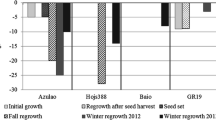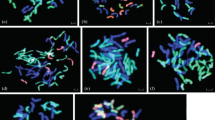Abstract
Manipulating apomixis for fixing tetraploid bahiagrass (Paspalum notatum Flüggé) hybrids exhibiting superior agronomic characteristics would be a valuable tool for the genetic improvement of this species. The objectives were to create a second generation of hybrids by crossing sexual first-generation tetraploid hybrids (FGTH) and unrelated apomictic FGTH or ecotypes, determine the segregation for mode of reproduction, and estimate the resulting genetic variation and heterosis for several agronomic characteristics. The segregation for mode of reproduction was analyzed using mature embryo sac observations. Field measurements and visual ratings were used to evaluate the growth habit, production of inflorescences, cool-season growth and freeze resistance of hybrids. A ratio of 4.6:1 between sexual and apomictic hybrids was observed. Only 3% of the progeny was classified as highly apomictic. The low proportion of highly apomictic progeny restricts the feasibility of this breeding approach. Large genetic variation was observed among hybrids for growth habit, cool-season growth and freeze resistance. The proportion of hybrids exhibiting heterosis was high for plant height, cool-season growth, and freeze resistance. The tetraploid bahiagrass germplasm contains a large diversity for traits of agronomic importance that can be exploited for the genetic improvement of this species.
Similar content being viewed by others
References
Acuña CA, Blount AR, Quesenberry KH, Hanna WW, Kenworthy KE (2007) Reproductive characterization of bahiagrass germplasm. Crop Sci 47:1711–1717
Acuña CA, Blount AR, Quesenberry KH, Kenworthy KE, Hanna WW (2009) Bahiagrass tetraploid germplasm: reproductive and agronomic characterization of segregating progeny. Crop Sci 49:581–588
Bashaw EC, Hanna WW (1990) Apomictic reproduction. In: Chapman GP (ed) Reproduction versatility in grasses. Cambridge University Press, Cambridge, pp 100–130
Blount AR, Acuña CA (2009) Bahiagrass. In: Singh RJ (ed) Genetic resources, chromosome engineering, and crop improvement series: forage crops, vol 5. CRC press, Boca Raton, FL, pp 81–101
Burton GW (1948) The method of reproduction in common bahiagrass, Paspalum notatum. J Am Soc Agron 40:443–452
Burton GW (1955) Breeding Pensacola bahiagrass, Paspalum notatum: I. Method of reproduction. Agron J 47:311–314
Burton GW (1982) Effect of environment on apomixis in bahiagrass. Crop Sci 22:109–111
Forbes I, Burton GW (1961) Cytology of diploids, natural and induced tetraploids, and intraspecific hybrids of bahiagrass, Paspalum notatum Flügge. Crop Sci 1:402–406
Gates RN, Quarin CL, Pedreira CGS (2004) Bahiagrass. In: Moser LE, Burson BL, Sollenberger LE (eds) Warm-season (C4) grasses. ASA, CSSA, SSSA, Madison, WI, pp 651–680
Hanna WW, Bashaw EC (1987) Apomixis: its identification and use in plant breeding. Crop Sci 27:1136–1139
Martínez EJ, Urbani MH, Quarin CL, Ortiz JPA (2001) Inheritance of apospory in bahiagrass, Paspalum notatum. Hereditas 135:19–25
Martínez EJ, Hopp HE, Stein J, Ortiz JPA, Quarin CL (2003) Genetic characterization of apospory in tetraploid Paspalum notatum based on the identification of linked molecular markers. Mol Breed 12:319–327
Quarin CL (1986) Seasonal changes in the incidence of apomixis of diploid, triploid, and tetraploid plants of Paspalum cromyorrhizon. Euphytica 35:515–522
Quarin CL (1992) The nature of apomixis and its origin in Panicoid grasses. Apomixis Newsl 5:8–15
Quarin CL, Espinoza F, Martínez EJ, Pessino SC, Bovo OA (2001) A rise of ploidy level induces the expression of apomixis in Paspalum notatum. Sex Plant Reprod 13:243–249
Quesenberry KH, Dampier JM, Lee YY, Smith RL, Acuña CA (2010) Doubling the chromosome number of bahiagrass via tissue culture. Euphytica 175:43–50
Sinclair TR, Mislevy P, Ray JD (2001) Short photoperiod inhibits winter growth of subtropical grasses. Planta 213:488–491
Statistical Analysis Institute (2004) SAS/STAT user’s guide release. Release 9.0. Statistical Analysis Institute, Cary, NC
Stein J, Quarin CL, Martínez EJ, Pessino SC, Ortiz JPA (2004) Tetraploid races of Paspalum notatum show polysomic inheritance and preferential chromosome pairing around the apospory-controlling locus. Theor Appl Genet 109:186–191
Stein J, Pessino SC, Martínez EJ, Rodriguez MP, Siena LE, Quarin CL, Ortiz JPA (2007) A genetic map of tetraploid Paspalum notatum Flügge (bahiagrass) based on single-dose molecular markers. Mol Breed 20:153–166
Young BA, Sherwood RT, Bashaw EC (1979) Cleared pistil and thick sectioning techniques for detecting aposporous apomixis in grasses. Can J Bot 57:1668–1672
Author information
Authors and Affiliations
Corresponding author
Rights and permissions
About this article
Cite this article
Acuña, C.A., Blount, A.R., Quesenberry, K.H. et al. Tetraploid bahiagrass hybrids: breeding technique, genetic variability and proportion of heterotic hybrids. Euphytica 179, 227–235 (2011). https://doi.org/10.1007/s10681-010-0276-y
Received:
Accepted:
Published:
Issue Date:
DOI: https://doi.org/10.1007/s10681-010-0276-y




